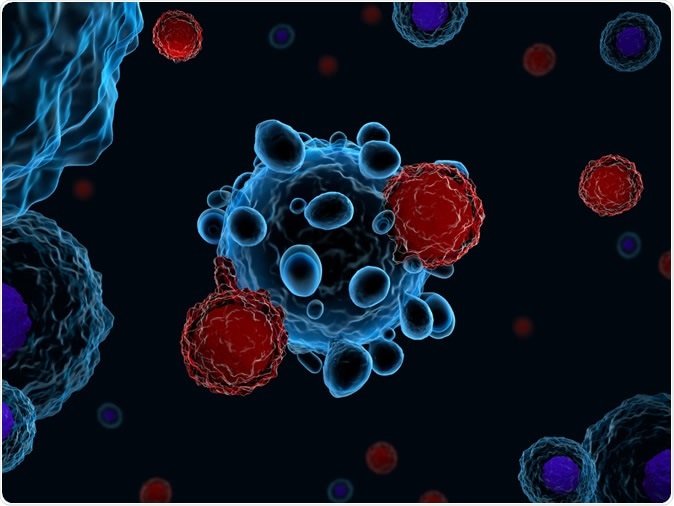The central point of the research was on the changing composition of protein condensates inside cells. Protein condensates refer to the clusters formed by different types of proteins to form intracellular compartments without the need for membranes around them.
Such condensates have been found to play essential parts in biological pathways, both in health and in disease. Their roles are determined by their components and primary locations within the cell. Thus they can take part in several very different processes like DNA replication, nerve impulse transmission between synapses, RNA processing and stress reactions, depending on their individual functions. They are also found in several cancers, in the crippling condition called amyotrophic lateral sclerosis, and Huntington’s disease.

3d illustration of immune system T cells attacking cancer cells (CAR T-cell therapy). Image Credit: Meletios Verras / Shutterstock
Condensates form through multiple interactions of molecules that have the ability to bind at multiple points. They build up around one or more of a small set of protein or RNA molecules, as if on a scaffolding. The way the proteins on the scaffold with other proteins and scaffolds determines the final composition of the condensate, which in turn decides its functions. This can change in response to regulatory signals, but the mechanisms are poorly understood.
One such intracellular pathway is the activation of the immune response via T cell receptors. T lymphocytes are white blood cells concerned with cellular immunity. They recognize specific molecules called antigens on foreign particles, typically presented to the passing T cell by an antigen presenting cell (APC). T cell-APC binding occurs only if the antigen perfectly fits the T cell receptors. This activates the t cell to proliferate rapidly, while also triggering the process of specific antibody production, while simultaneously signaling the antigen’s presence to the rest of the body to recruit further defenses.
The current research focuses on how T cells are activated upon binding to an APC. Upon binding, T cell receptors initiate a cascade of processes mediated by proteins called the T cell signaling complex.
The LAT (Linker for Activation of T cells) protein in the cortex or periphery of the T cell forms a nucleus for specific condensates at the APC-T cell interface or immunological synapse (IS). Actin and myosin filaments in the cytoplasm form both radial and concentric moving networks in the cortex which guides the LAT condensate towards the center of the IS, to maintain the state of activation of the T cell. The question was how these two processes link up with each other to regulate activated T cell function.
Researchers used two independent advances: an in vitro artificially built LAT condensate and an in vitro actomyosin cortex membrane. These were brought together to examine how an actively moving actin filament network interacted with the condensate. The use of the rebuilt system allowed them to make very subtle changes to the composition of the protein assembly that would have been far more difficult in a living cell.
The scientists found that the coupling of the T cell signaling complex and the actomyosin cytoskeleton was by means of two proteins called Nck and N-WASP/WASP which slot the LAT protein condensate into the actin network in different regions as required. This geared up the network to move the condensate towards the cell center at higher speeds. As the radial actin network gave way to a concentric one, the Nck molecule disappeared from the LAT condensate. When this loss was prevented by engineering the condensate, the movement of the protein cluster became disorderly. Thus the cell can alter the composition of the LAT condensate to move it radially to the center of the IS. The final outcome was the modulation of T cell receptors to stimulate immune defenses against the foreign antigens.
Darius Koster of Warwick Medical School explains, “Depending on which modular molecules are used in the LAT clusters, their interaction with actin changes. It's a bit like a clutch in your car, some molecules interact weakly with the actin, but by adding another molecule they will interact much more strongly.”
The research brings in better understanding of how the immune response is regulated, which could allow specifically activated T cells to be designed for particular uses. The study was also unique for the sharing of scientific discoveries across several national groups, which enabled the breakthrough to be made.
Researcher Michael Rosen says, “By living and working together for eight weeks over several summers, we were able to make scientific discoveries that would have been impossible for any of our groups individually.”
The paper was published in the journal eLife on July 3, 2019.
Journal reference:
Jonathon A Ditlev, Anthony R Vega, Darius Vasco Köster, Xiaolei Su, Tomomi Tani, Ashley M Lakoduk, Ronald D Vale, Satyajit Mayor, Khuloud Jaqaman, Michael K Rosen, 'A composition-dependent molecular clutch between T cell signaling condensates and actin', eLife 2019;8:e42695 DOI: 10.7554/eLife.42695, https://elifesciences.org/articles/42695